思科路由器交换机常用配置命令
- 格式:doc
- 大小:151.50 KB
- 文档页数:37

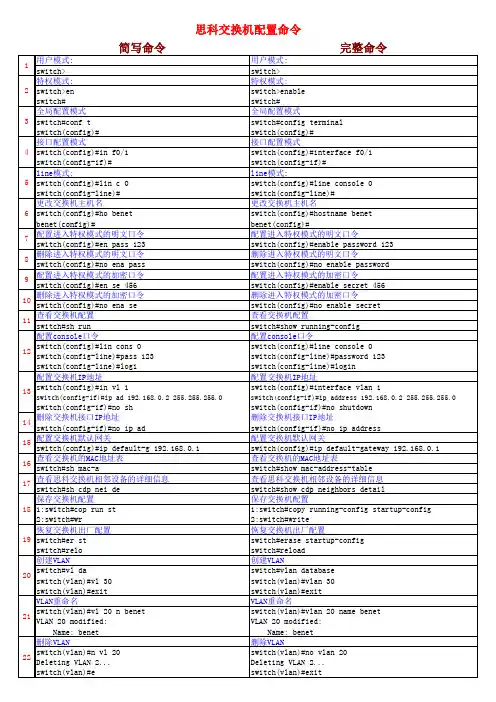
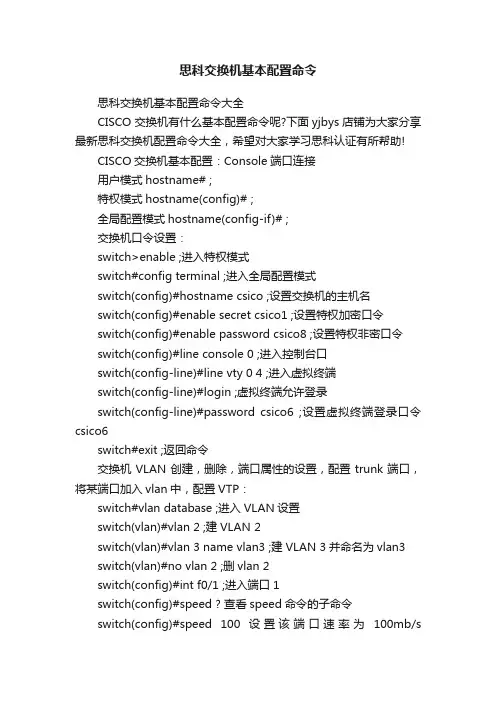
思科交换机基本配置命令 思科交换机基本配置命令大全 CISCO交换机有什么基本配置命令呢?下面yjbys店铺为大家分享最新思科交换机配置命令大全,希望对大家学习思科认证有所帮助! CISCO交换机基本配置:Console端口连接 用户模式hostname# ; 特权模式hostname(config)# ; 全局配置模式hostname(config-if)# ; 交换机口令设置: switch>enable ;进入特权模式 switch#config terminal ;进入全局配置模式 switch(config)#hostname csico ;设置交换机的主机名 switch(config)#enable secret csico1 ;设置特权加密口令 switch(config)#enable password csico8 ;设置特权非密口令 switch(config)#line console 0 ;进入控制台口 switch(config-line)#line vty 0 4 ;进入虚拟终端 switch(config-line)#login ;虚拟终端允许登录 switch(config-line)#password csico6 ;设置虚拟终端登录口令csico6 switch#exit ;返回命令 交换机VLAN创建,删除,端口属性的设置,配置trunk端口,将某端口加入vlan中,配置VTP: switch#vlan database ;进入VLAN设置 switch(vlan)#vlan 2 ;建VLAN 2 switch(vlan)#vlan 3 name vlan3 ;建VLAN 3并命名为vlan3 switch(vlan)#no vlan 2 ;删vlan 2 switch(config)#int f0/1 ;进入端口1 switch(config)#speed ? 查看speed命令的子命令 switch(config)#speed 100 设置该端口速率为100mb/s (10/auto) switch(config)#duplex ? 查看duplex的子命令 switch(config)#duplex full 设置该端口为全双工(auto/half) switch(config)#description TO_PC1 这是该端口描述为TO_PC1 switch(config-if)#switchport access vlan 2 ;当前端口加入vlan 2 switch(config-if)#switchport mode trunk ;设置为trunk模式(access模式) switch(config-if)#switchport trunk allowed vlan 1,2 ;设置允许的vlan switch(config-if)#switchport trunk encap dot1q ;设置vlan 中继 switch(config)#vtp domain vtpserver ;设置vtp域名相同 switch(config)#vtp password ;设置发vtp密码 switch(config)#vtp server ;设置vtp服务器模式 switch(config)#vtp client ;设置vtp客户机模式 交换机设置IP地址,默认网关,域名,域名服务器,配置和查看MAC地址表: switch(config)#interface vlan 1 ;进入vlan 1 switch(config-if)#ip address 192.168.1.1 255.255.255.0 ;设置IP地址 switch(config)#ip default-gateway 192.168.1.6 ;设置默认网关 switch(config)#ip domain-name cisco.com 设置域名 switch(config)#ip name-server 192.168.1.18 设置域名服务器 switch(config)#mac-address-table? 查看mac-address-table的子命令 switch(config)#mac-address-table aging-time 100 设置超时时间为100ms switch(config)#mac-address-table permanent 0000.0c01.bbcc f0/3 加入永久地址在f0/3端口 switch(config)#mac-address-table restricted static 0000.0c02.bbcc f0/6 f0/7 加入静态地址目标端口f0/6源端口f0/7 switch(config)#end switch#show mac-address-table 查看整个MAC地址表 switch#clear mac-address-table restricted static 清除限制性静态地址 交换机显示命令: switch#write ;保存配置信息 switch#show vtp ;查看vtp配置信息 switch#show run ;查看当前配置信息 switch#show vlan ;查看vlan配置信息 switch#show interface ;查看端口信息 switch#show int f0/0 ;查看指定端口信息 switch#show int f0/0 status;查看指定端口状态 switch#dir flash: ;查看闪存 (1)模式转换命令 用户模式----特权模式,使用命令"enable" 特权模式----全局配置模式,使用命令"config t" 全局配置模式----接口模式,使用命令"interface+接口类型+接口号" 全局配置模式----线控模式,使用命令"line+接口类型+接口号" 注: 用户模式:查看初始化的信息. 特权模式:查看所有信息、调试、保存配置信息 全局模式:配置所有信息、针对整个路由器或交换机的所有接口 接口模式:针对某一个接口的配置 线控模式:对路由器进行控制的.接口配置 (2)配置命令 show running config 显示所有的配置 show versin 显示版本号和寄存器值 shut down 关闭接口 no shutdown 打开接口 ip add +ip地址 配置IP地址 secondary+IP地址 为接口配置第二个IP地址 show interface+接口类型+接口号 查看接口管理性 show controllers interface 查看接口是否有DCE电缆 show history 查看历史记录 show terminal 查看终端记录大小 hostname+主机名 配置路由器或交换机的标识 config memory 修改保存在NVRAM中的启动配置 exec timeout 0 0 设置控制台会话超时为0 service password-encryptin 手工加密所有密码 enable password +密码 配置明文密码 ena sec +密码 配置密文密码 line vty 0 4/15 进入telnet接口 password +密码 配置telnet密码 line aux 0 进入AUX接口 password +密码 配置密码 line con 0 进入CON接口 password +密码 配置密码 bandwidth+数字 配置带宽 no ip address 删除已配置的IP地址 show startup config 查看NVRAM中的配置信息 copy run-config atartup config 保存信息到NVRAM write 保存信息到NVRAM erase startup-config 清除NVRAM中的配置信息 show ip interface brief 查看接口的谪要信息 banner motd # +信息 + # 配置路由器或交换机的描素信息 description+信息 配置接口听描素信息 vlan database 进入VLAN数据库模式 vlan +vlan号+ 名称 创建VLAN switchport access vlan +vlan号 为VLAN为配接口 interface vlan +vlan号 进入VLAN接口模式 ip add +ip地址 为VLAN配置管理IP地址 vtp+service/tracsparent/client 配置SW的VTP工作模式 vtp +domain+域名 配置SW的VTP域名 vtp +password +密码 配置SW的密码 switchport mode trunk 启用中继 no vlan +vlan号 删除VLAN show spamming-tree vlan +vlan号 查看VLA怕生成树议 2. 路由器配置命令 ip route+非直连网段+子网掩码+下一跳地址 配置静态/默认路由 show ip route 查看路由表 show protocols 显示出所有的被动路由协议和接口上哪些协议被设置 show ip protocols 显示了被配置在路由器上的路由选择协议,同时给出了在路由选择协议中使用的定时器等信息 router rip 激活RIP协议 network +直连网段 发布直连网段 interface lookback 0 激活逻辑接口 passive-interface +接口类型+接口号 配置接口为被动模式 debug ip +协议 动态查看路由更新信息 undebug all 关闭所有DEBUG信息 router eigrp +as号 激活EIGRP路由协议 network +网段+子网掩码 发布直连网段 show ip eigrp neighbors 查看邻居表 show ip eigrp topology 查看拓扑表 show ip eigrp traffic 查看发送包数量 router ospf +process-ID 激活OSPF协议 network+直连网段+area+区域号 发布直连网段

思科路由器配置命令大全1. switch配置命令(1)模式转换命令用户模式----特权模式,使用命令"enable"特权模式----全局配置模式,使用命令"config t"全局配置模式----接口模式,使用命令"interface+接口类型+接口号" 全局配置模式----线控模式,使用命令"line+接口类型+接口号"注:用户模式:查看初始化的信息.特权模式:查看所有信息、调试、保存配置信息全局模式:配置所有信息、针对整个路由器或交换机的所有接口接口模式:针对某一个接口的配置线控模式:对路由器进行控制的接口配置(2)配置命令show running config 显示所有的配置show versin 显示版本号和寄存器值shut down 关闭接口no shutdown 打开接口ip add +ip地址配置IP地址secondary+IP地址为接口配置第二个IP地址show interface+接口类型+接口号查看接口管理性show controllers interface 查看接口是否有DCE电缆show history 查看历史记录show terminal 查看终端记录大小hostname+主机名配置路由器或交换机的标识config memory 修改保存在NVRAM中的启动配置exec timeout 0 0 设置控制台会话超时为0service password-encryptin 手工加密所有密码enable password +密码配置明文密码ena sec +密码配置密文密码line vty 0 4/15 进入telnet接口password +密码配置telnet密码line aux 0 进入AUX接口password +密码配置密码line con 0 进入CON接口password +密码配置密码bandwidth+数字配置带宽no ip address 删除已配置的IP地址show startup config 查看NVRAM中的配置信息copy run-config atartup config 保存信息到NVRAMwrite 保存信息到NVRAMerase startup-config 清除NVRAM中的配置信息show ip interface brief 查看接口的谪要信息banner motd # +信息+ # 配置路由器或交换机的描素信息description+信息配置接口听描素信息vlan database 进入VLAN数据库模式vlan +vlan号+ 名称创建VLANswitchport access vlan +vlan号为VLAN为配接口interface vlan +vlan号进入VLAN接口模式ip add +ip地址为VLAN配置管理IP地址vtp+service/tracsparent/client 配置SW的VTP工作模式vtp +domain+域名配置SW的VTP域名vtp +password +密码配置SW的密码switchport mode trunk 启用中继no vlan +vlan号删除VLANshow spamming-tree vlan +vlan号查看VLA怕生成树议2. 路由器配置命令ip route+非直连网段+子网掩码+下一跳地址配置静态/默认路由show ip route 查看路由表show protocols 显示出所有的被动路由协议和接口上哪些协议被设置show ip protocols 显示了被配置在路由器上的路由选择协议,同时给出了在路由选择协议中使用的定时器等信息router rip 激活RIP协议network +直连网段发布直连网段interface lookback 0 激活逻辑接口passive-interface +接口类型+接口号配置接口为被动模式debug ip +协议动态查看路由更新信息undebug all 关闭所有DEBUG信息router eigrp +as号激活EIGRP路由协议network +网段+子网掩码发布直连网段show ip eigrp neighbors 查看邻居表show ip eigrp topology 查看拓扑表show ip eigrp traffic 查看发送包数量router ospf +process-ID 激活OSPF协议network+直连网段+area+区域号发布直连网段show ip ospf 显示OSPF的进程号和ROUTER-IDencapsulation+封装格式更改封装格式no ip admain-lookup 关闭路由器的域名查找ip routing 在三层交换机上启用路由功能show user 查看SW的在线用户clear line +线路号清除线路3. 三层交换机配置命令配置一组二层端口configure terminal 进入配置状态nterface range {port-range} 进入组配置状态配置三层端口configure terminal 进入配置状态interface {{fastethernet | gigabitethernet} interface-id} | {vlan vlan-id} | {port- channel port-channel-number} 进入端口配置状态no switchport 把物理端口变成三层口ip address ip_address subnet_mask 配置IP地址和掩码no shutdown 激活端口例:Switch(config)# interface gigabitethernet0/2Switch(config-if)# no switchportSwitch(config-if)# ip address 192.20.135.21 255.255.255.0Switch(config-if)# no shutdown配置VLANconfigure terminal 进入配置状态vlan vlan-id 输入一个VLAN号, 然后进入vlan配态,可以输入一个新的VLAN 号或旧的来进行修改。

交换机支持的命令:(注:交换机支持命令对应的为思科2系列以上型号的交换机。
)交换机基本状态:switch: ;交换机的ROM态rommon> ;路由器的R状态switch > ;用户模式switch# ;特权模式switch(config)# ;全局配置模式switch(vlan)# 交换机VLAN配置模式switch(config-if)# ;端口配置模式switch(config-line)# ; 指定连接状态(console连接telnet连接)交换机显示命令:switch#write ;保存配置信息switch#show running ;查看当前配置信息switch#show startup 查看交换机NVROM配置信息switch#show vlan ;查看vlan配置信息switch#show vlan-switch 同样为查看vlan配置信息(一些高端交换机比如3系列的交换机必须用这个命令才能查看vlan配置信息)switch#show vtp status 查看VTP配置信息switch#show interface ;查看所有的端口信息switch#show interface f0/3 ;查看指定的f0/3快速以太网端口信息switch#show interfacef0/3 switchport 查看指定的f0/3快速以太网端口trunk信息switch #show ip inerface brief 用类似表格的形式列出路由器或者交换机接口对应的第三层配置,这个命令是使用频率最高的一个,也是最实用的一个。
switch #show spanning-tree 查看交换机生成树协议情况switch #show spanning-tree vlan 2 查看交换机VLAN2的生成树协议情况switch #show spanning-tree interface f0/1 查看交换机F0/1端口生成树协议情况switch #show cdp 显示交换机当前邻居更新信息switch #show cdp neighbor ;显示邻居直连路由信息switch #show cdp neighbor detail 显示邻居直连路由详细信息switch #show cdp interface 显示所有端口是否开启cdp功能switch (config-if)#no cdp enable 关闭指定端口的cdp功能switch (config-if)#cdp enable 打开指定端口的cdp功能switch (config)#no cdp run 关闭所有端口的cdp功能switch (config)#cdp run 打开所有端口的cdp功能switch#show version 查看交换机版本信息switch#show flash 查看flash里面的IOS信息switch#show mac-address-table 查看交换机所有端口的MAC地址信息switch#show logging 查看交换机日志信息交换机口令设置:switch>enable ;进入特权模式switch#config terminal ;进入全局配置模式switch(config)#hostname <hostname> 设置交换机的主机名switch(config)#enable secret xxx ;设置特权加密口令(真正进入enable特权模式需要输入这个口令)switch(config)#enable password xxa ;设置特权非密口令登录console控制台需要输入密码的方法switch(config)#line console 0 ;进入console控制台口switch(config-line)#login ;允许登录控制台switch (config-line)# password xx 设置登陆控制台口口令switch (config-line)#exec-timeout 0 0 设置控制台口多长时间不操作会自动退出,前面一个0表示分钟后面一个0表示秒两个都是0表示一直不会自动退出。
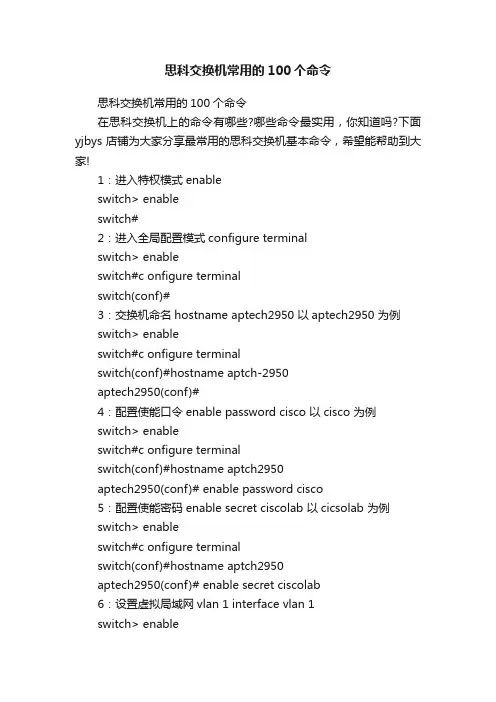
思科交换机常用的100个命令思科交换机常用的100个命令在思科交换机上的命令有哪些?哪些命令最实用,你知道吗?下面yjbys店铺为大家分享最常用的思科交换机基本命令,希望能帮助到大家!1:进入特权模式enableswitch> enableswitch#2:进入全局配置模式configure terminalswitch> enableswitch#c onfigure terminalswitch(conf)#3:交换机命名hostname aptech2950 以aptech2950 为例switch> enableswitch#c onfigure terminalswitch(conf)#hostname aptch-2950aptech2950(conf)#4:配置使能口令enable password cisco 以cisco 为例switch> enableswitch#c onfigure terminalswitch(conf)#hostname aptch2950aptech2950(conf)# enable password cisco5:配置使能密码enable secret ciscolab 以cicsolab 为例switch> enableswitch#c onfigure terminalswitch(conf)#hostname aptch2950aptech2950(conf)# enable secret ciscolab6:设置虚拟局域网vlan 1 interface vlan 1switch> enableswitch#c onfigure terminalswitch(conf)#hostname aptch2950aptech2950(conf)# interface vlan 1aptech2950(conf-if)#ip address 192.168.1.1 255.255.255.0 配置交换机端口ip 和子网掩码aptech2950(conf-if)#no shut 是配置处于运行中aptech2950(conf-if)#exitaptech2950(conf)#ip default-gateway 192.168.254 设置网关地址7:进入交换机某一端口interface fastehernet 0/17 以17 端口为例switch> enableswitch#c onfigure terminalswitch(conf)#hostname aptch2950aptech2950(conf)# interface fastehernet 0/17aptech2950(conf-if)#8:查看命令showswitch> enableswitch# show version 察看系统中的所有版本信息show interface vlan 1 查看交换机有关ip 协议的配置信息show running-configure 查看交换机当前起作用的配置信息show interface fastethernet 0/1 察看交换机1 接口具体配置和统计信息show mac-address-table 查看mac 地址表show mac-address-table aging-time 查看mac 地址表自动老化时间9:交换机恢复出厂默认恢复命令switch> enableswitch# erase startup-configureswitch# reload10:双工模式设置switch> enableswitch#c onfigure terminalswitch2950(conf)#hostname aptch-2950aptech2950(conf)# interface fastehernet 0/17 以17 端口为例aptech2950(conf-if)#duplex full/half/auto 有full , half, auto 三个可选项11:cdp 相关命令switch> enableswitch# show cdp 查看设备的cdp 全局配置信息show cdp interface fastethernet 0/17 查看17 端口的cdp 配置信息show cdp traffic 查看有关cdp 包的统计信息show cdp nerghbors 列出与设备相连的cisco 设备12:csico2950 的密码恢复拔下交换机电源线。

H3C的路由器配置命令详解en 进入特权模式conf 进入全局配置模式in s0 进入 serial 0 端口配置ip add xxx.xxx.xxx.xxx xxx.xxx.xxx.xxx 添加ip 地址和掩码,电信分配enca hdlc/ppp 捆绑链路协议hdlc 或者pppip unn e0exit 回到全局配置模式in e0 进入以太接口配置ip add xxx.xxx.xxx.xxx xxx.xxx.xxx.xxx 添加ip 地址和掩码,电信分配exit 回到全局配置模式ip route 0.0.0.0 0.0.0.0 s 0 添加路由表ena password 口令writeexit以上根据中国电信ddn 专线多数情况应用普通用户模式enable 转入特权用户模式exit 退出配置help 系统帮助简述language 语言模式切换ping 检查网络主机连接及主机是否可达show 显示系统运行信息telnet 远程登录功能tracert 跟踪到目的地经过了哪些路由器特权用户模式#?clear 清除各项统计信息clock 管理系统时钟configure 进入全局配置模式debug 开启调试开关disable 返回普通用户模式download 下载新版本软件和配置文件erase 擦除FLASH中的配置exec-timeout 打开EXEC超时退出开关exit 退出配置first-config 设置或清除初次配置标志help 系统帮助简述language 语言模式切换monitor 打开用户屏幕调试信息输出开关no 关闭调试开关ping 检查网络主机连接及主机是否可达reboot 路由器重启setup 配置路由器参数show 显示系统运行信息telnet 远程登录功能tracert 跟踪到目的地经过了哪些路由器unmonitor 关闭用户屏幕调试信息输出开关write 将当前配置参数保存至FLASH MEM中全局配置模式aaa-enable 使能配置AAA(认证,授权和计费) access-list 配置标准访问表arp 设置静态ARP人口chat-script 生成一个用在modem上的执行脚本custom-list 创建定制队列列表dialer-list 创建dialer-listdram-wait 设置DRAM等待状态enable 修改ENABLE口令exit 退出全局配置模式firewall 配置防火墙状态flow-interval 设置流量控制时间间隔frame-relay 帧中继全局配置命令集ftp-server FTP 服务器help 系统帮助命令简述host 添加主机名称和其IP地址hostname 修改主机名ifquelen 更改接口队列长度interface 选择配置接口ip 全局IP配置命令子集ipx 全局IPX配置命令子集loghost 设置日志主机IP地址logic-channel 配置逻辑通道login 启动EXEC登录验证modem-timeout 设置modem 超时时间multilink 配置multilink 用户使用的接口multilink-user 配置multilink 用户使用的接口natserver 设置FTP,TELNET,WWW服务的IP地址no 关闭某些参数开关priority-list 创建优先级队列列表router 启动路由处理settr 设置时间范围snmp-server 修改SNMP参数tcp 配置全局TCP参数timerange 启动或关闭时间区域user 为PPP验证向系统中加入用户vpdn 设置VPDNvpdn-group 设置VPDN组x25 X.25协议分组层H3C交换机常用命令解释作者:admin 日期:2009-12-19字体大小: 小中大H3C交换机常用命令注释H3C交换机######################################################## ###############31、system-view 进入系统视图模式2、sysname 为设备命名3、display current-configuration 当前配置情况4、language-mode Chinese|English 中英文切换5、interface Ethernet 1/0/1 进入以太网端口视图6、port link-type Access|Trunk|Hybrid 设置端口访问模式7、undo shutdown 打开以太网端口8、shutdown 关闭以太网端口9、quit 退出当前视图模式10、vlan 10 创建VLAN 10并进入VLAN 10的视图模式11、port access vlan 10 在端口模式下将当前端口加入到vlan 10中12、port E1/0/2 to E1/0/5 在VLAN模式下将指定端口加入到当前vlan中13、port trunk permit vlan all 允许所有的vlan通过H3C路由器######################################################## ##############################1、system-view 进入系统视图模式2、sysname R1 为设备命名为R13、display ip routing-table 显示当前路由表4、language-mode Chinese|English 中英文切换5、interface Ethernet 0/0 进入以太网端口视图6、ip address 192.168.1.1 255.255.255.0 配置IP地址和子网掩码7、undo shutdown 打开以太网端口8、shutdown 关闭以太网端口9、quit 退出当前视图模式10、ip route-static 192.168.2.0 255.255.255.0 192.168.12.2 description To.R2 配置静态路由11、ip route-static 0.0.0.0 0.0.0.0 192.168.12.2 description To.R2 配置默认的路由H3C S3100 SwitchH3C S3600 SwitchH3C MSR 20-20 Router######################################################## ##################################1、调整超级终端的显示字号;2、捕获超级终端操作命令行,以备日后查对;3、language-mode Chinese|English 中英文切换;4、复制命令到超级终端命令行,粘贴到主机;5、交换机清除配置:reset save ;reboot ;6、路由器、交换机配置时不能掉电,连通测试前一定要检查网络的连通性,不要犯最低级的错误。

Cisco路由器交换机配置命令大全1. switch配置命令(1)模式转换命令用户模式----特权模式,使用命令"enable"特权模式----全局配置模式,使用命令"config t"全局配置模式----接口模式,使用命令"interface+接口类型+接口号" 全局配置模式----线控模式,使用命令"line+接口类型+接口号" 注::用户模式:查看初始化的信息.特权模式:查看所有信息、调试、保存配置信息全局模式:配置所有信息、针对整个路由器或交换机的所有接口接口模式:针对某一个接口的配置线控模式:对路由器进行控制的接口配置(2)配置命令show running config 显示所有的配置show versin 显示版本号和寄存器值shut down 关闭接口no shutdown 打开接口ip add +ip地址配置IP地址secondary+IP地址为接口配置第二个IP地址show interface+接口类型+接口号查看接口管理性show controllers interface 查看接口是否有DCE电缆show history 查看历史记录show terminal 查看终端记录大小hostname+主机名配置路由器或交换机的标识config memory 修改保存在NVRAM中的启动配置exec timeout 0 0 设置控制台会话超时为0service password-encryptin 手工加密所有密码enable password +密码配置明文密码ena sec +密码配置密文密码line vty 0 4/15 进入telnet接口password +密码配置telnet密码line aux 0 进入AUX接口password +密码配置密码line con 0 进入CON接口password +密码配置密码bandwidth+数字配置带宽no ip address 删除已配置的IP地址show startup config 查看NVRAM中的配置信息copy run-config atartup config 保存信息到NVRAMwrite 保存信息到NVRAMerase startup-config 清除NVRAM中的配置信息show ip interface brief 查看接口的谪要信息banner motd # +信息+ # 配置路由器或交换机的描素信息description+信息配置接口听描素信息vlan database 进入VLAN数据库模式vlan +vlan号+ 名称创建VLANswitchport access vlan +vlan号为VLAN为配接口interface vlan +vlan号进入VLAN接口模式ip add +ip地址为VLAN配置管理IP地址vtp+service/tracsparent/client 配置SW的VTP工作模式vtp +domain+域名配置SW的VTP域名vtp +password +密码配置SW的密码switchport mode trunk 启用中继no vlan +vlan号删除VLANshow spamming-tree vlan +vlan号查看VLA怕生成树议2. 路由器配置命令ip route+非直连网段+子网掩码+下一跳地址配置静态/默认路由show ip route 查看路由表show protocols 显示出所有的被动路由协议和接口上哪些协议被设置show ip protocols 显示了被配置在路由器上的路由选择协议,同时给出了在路由选择协议中使用的定时器等信息router rip 激活RIP协议network +直连网段发布直连网段interface lookback 0 激活逻辑接口passive-interface +接口类型+接口号配置接口为被动模式debug ip +协议动态查看路由更新信息undebug all 关闭所有DEBUG信息router eigrp +as号激活EIGRP路由协议network +网段+子网掩码发布直连网段show ip eigrp neighbors 查看邻居表show ip eigrp topology 查看拓扑表show ip eigrp traffic 查看发送包数量router ospf +process-ID 激活OSPF协议network+直连网段+area+区域号发布直连网段show ip ospf 显示OSPF的进程号和ROUTER-ID encapsulation+封装格式更改封装格式no ip admain-lookup 关闭路由器的域名查找ip routing 在三层交换机上启用路由功能show user 查看SW的在线用户clear line +线路号清除线路3. 三层交换机配置命令配置一组二层端口configure terminal 进入配置状态nterface range {port-range} 进入组配置状态配置三层端口configure terminal 进入配置状态interface {{fastethernet | gigabitethernet} interface-id} | {vlan vlan-id} | {port-channel port-channel-number} 进入端口配置状态no switchport 把物理端口变成三层口ip address ip_address subnet_mask 配置IP地址和掩码no shutdown 激活端口例:Switch(config)# interface gigabitethernet0/2Switch(config-if)# no switchportSwitch(config-if)# ip address 192.20.135.21 255.255.255.0Switch(config-if)# no shutdown配置VLANconfigure terminal 进入配置状态vlan vlan-id 输入一个VLAN号, 然后进入vlan配态,可以输入一个新的VLAN号或旧的来进行修改。
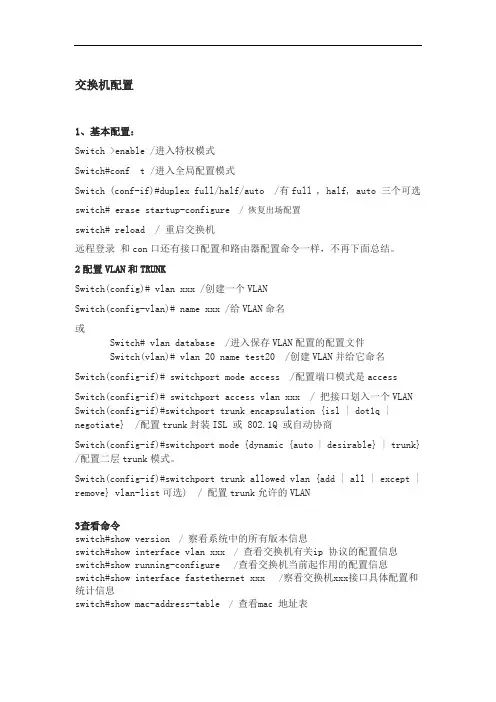
交换机配置1、基本配置:Switch >enable /进入特权模式Switch#conf t /进入全局配置模式Switch (conf-if)#duplex full/half/auto /有full , half, auto 三个可选switch# erase startup-configure / 恢复出场配置switch# reload / 重启交换机远程登录和con口还有接口配置和路由器配置命令一样,不再下面总结。
2配置VLAN和TRUNKSwitch(config)# vlan xxx /创建一个VLANSwitch(config-vlan)# name xxx /给VLAN命名或Switch# vlan database /进入保存VLAN配置的配置文件Switch(vlan)# vlan 20 name test20 /创建VLAN并给它命名Switch(config-if)# switchport mode access /配置端口模式是accessSwitch(config-if)# switchport access vlan xxx / 把接口划入一个VLAN Switch(config-if)#switchport trunk encapsulation {isl | dot1q | negotiate} /配置trunk封装ISL 或 802.1Q 或自动协商Switch(config-if)#switchport mode {dynamic {auto | desirable} | trunk} /配置二层trunk模式。
Switch(config-if)#switchport trunk allowed vlan {add | all | except | remove} vlan-list可选) / 配置trunk允许的VLAN3查看命令switch#show version /察看系统中的所有版本信息switch#show interface vlan xxx /查看交换机有关ip 协议的配置信息switch#show running-configure /查看交换机当前起作用的配置信息switch#show interface fastethernet xxx /察看交换机xxx接口具体配置和统计信息switch#show mac-address-table /查看mac 地址表switch#show mac-address-table aging-time / 查看mac 地址表自动老化时间4 cdp 相关命令switch#show cdp / 查看设备的cdp 全局配置信息switch#show cdp interface fastethernet xxx /查看xxx 端口的cdp 配置信息switch#show cdp traffic / 查看有关cdp 包的统计信息switch#show cdp nerghbors / 列出与设备相连的cisco 设备VTP配置switch# vlan databaseswitch(vlan)# vtp domain xxx / 配置VTP名字Switch(vlan)#vtp server / 配置VTP模式为serverSwitch(vlan)#vtp client / 配置VTP模式为clientSwitch(vlan)#vtp password xxx / 配置VTP密码switch(vlan)# vtp pruning / 开启VTP剪裁switch#show vtp domain /显示管理域的VTP 参数还有没总结的,我会抓紧时间完善。
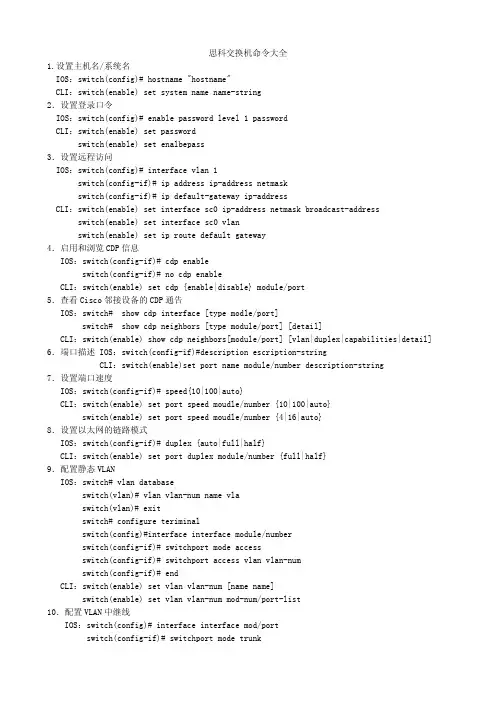
思科交换机命令大全1.设置主机名/系统名IOS:switch(config)# hostname "hostname"CLI:switch(enable) set system name name-string2.设置登录口令IOS:switch(config)# enable password level 1 passwordCLI:switch(enable) set passwordswitch(enable) set enalbepass3.设置远程访问IOS:switch(config)# interface vlan 1switch(config-if)# ip address ip-address netmaskswitch(config-if)# ip default-gateway ip-addressCLI:switch(enable) set interface sc0 ip-address netmask broadcast-address switch(enable) set interface sc0 vlanswitch(enable) set ip route default gateway4.启用和浏览CDP信息IOS:switch(config-if)# cdp enableswitch(config-if)# no cdp enableCLI:switch(enable) set cdp {enable|disable} module/port5.查看Cisco邻接设备的CDP通告IOS:switch# show cdp interface [type modle/port]switch# show cdp neighbors [type module/port] [detail]CLI:switch(enable) show cdp neighbors[module/port] [vlan|duplex|capabilities|detail] 6.端口描述 IOS:switch(config-if)#description escription-stringCLI:switch(enable)set port name module/number description-string7.设置端口速度IOS:switch(config-if)# speed{10|100|auto}CLI:switch(enable) set port speed moudle/number {10|100|auto}switch(enable) set port speed moudle/number {4|16|auto}8.设置以太网的链路模式IOS:switch(config-if)# duplex {auto|full|half}CLI:switch(enable) set port duplex module/number {full|half}9.配置静态VLANIOS:switch# vlan databaseswitch(vlan)# vlan vlan-num name vlaswitch(vlan)# exitswitch# configure teriminalswitch(config)#interface interface module/numberswitch(config-if)# switchport mode accessswitch(config-if)# switchport access vlan vlan-numswitch(config-if)# endCLI:switch(enable) set vlan vlan-num [name name]switch(enable) set vlan vlan-num mod-num/port-list10.配置VLAN中继线IOS:switch(config)# interface interface mod/portswitch(config-if)# switchport mode trunkswitch(config-if)#switchport trunk encapsulation {isl|dotlq}switch(config-if)# switchport trunk allowed vlan remove vlan-listswitch(config-if)# switchport trunk allowed vlan add vlan-list CLI:switch(enable)set trunk module/port [on|off|desirable|auto|nonegotiate] Vlan-range [isl|dotlq|dotl0|lane|negotiate]11.配置VTP管理域IOS:switch# vlan databaseswitch(vlan)# vtp domain domain-nameCLI:switch(enable) set vtp [domain domain-name]12.配置VTP 模式IOS:switch# vlan databaseswitch(vlan)# vtp domain domain-nameswitch(vlan)# vtp {sever|cilent|transparent}switch(vlan)# vtp password passwordCLI:switch(enable) set vtp [domain domain-name][mode{ sever|cilent|transparent }][password password]13.配置VTP版本IOS:switch# vlan databaseswitch(vlan)# vtp v2-modeCLI:switch(enable) set vtp v2 enable14.启动VTP剪裁IOS:switch# vlan databaseswitch(vlan)# vtp pruningCLI:switch(enable) set vtp pruning enable15.配置以太信道IOS:switch(config-if)# port group group-number [distribution {source|destination}] CLI:switch(enable) set port channel moudle/port-range mode{on|off|desirable|auto} 16.调整根路径成本IOS:switch(config-if)#spanning-tree [vlan vlan-list] cost costCLI:switch(enable)set spantree portcost moudle/port costswitch(enable)set spantree portvlancost moudle/port [cost cost][vlan-list] 17.调整端口IDIOS:switch(config-if)#spanning-tree[vlan vlan-list]port-priority port-priority CLI:switch(enable)set spantree portpri {mldule/port}priorityswitch(enable)set spantree portvlanpri {module/port}priority [vlans]18.修改STP时钟IOS:switch(config)# spanning-tree [vlan vlan-list] hello-time secondsswitch(config)#spanning-tree [vlan vlan-list] forward-time secondsswitch(config)#spanning-tree [vlan vlan-list] max-age seconds CLI:switch(enable) set spantree hello interval[vlan]switch(enable) set spantree fwddelay delay [vlan]switch(enable) set spantree maxage agingtiame[vlan]19.启用或禁用Port Fast 特征IOS:switch(config-if)#spanning-tree portfastCLI:switch(enable)set spantree portfast {module/port}{enable|disable}20.启用或禁用UplinkFast 特征IOS:switch(config)#spanning-tree uplinkfast [max-update-rate pkts-per-second]CLI:switch(enable)set spantree uplinkfast {enable|disable}[rate update-rate] [all-protocolsoff|on] 为了将交换机配置成一个集群的命令交换机,首先要给管理接口分配一个IP地址,然后使用下列命令: switch(config)# cluster enable cluster-name21. 为了从一条中继链路上删除VLAN,可使用下列命令:switch(enable) clear trunk module/port vlan-range22. 用show vtp domain 显示管理域的VTP参数.23. 用show vtp statistics显示管理域的VTP参数.24. 在Catalyst交换机上定义TrBRF的命令如下:switch(enable) set vlan vlan-name [name name] type trbrf bridge bridge-num[stp {ieee|ibm}] 25. 在Catalyst交换机上定义TrCRF的命令如下:switch (enable) set vlan vlan-num [name name] type trcrf {ring hex-ring-num|decring decimal-ring-num} parent vlan-num26. 在创建好TrBRF VLAN之后,就可以给它分配交换机端口.对于以太网交换,可以采用如下命令给VLAN分配端口:switch(enable) set vlan vlan-num mod-num/port-num27. 命令show spantree显示一个交换机端口的STP状态.28. 配置一个ELAN的LES和BUS,可以使用下列命令:ATM (config)# interface atm number.subint multiointATM(config-subif)# lane serber-bus ethernet elan-name29. 配置LECS:ATM(config)# lane database database-nameATM(lane-config-databade)# name elan1-name server-atm-address les1-nsap-addressATM(lane-config-databade)# name elan2-name server-atm-address les2-nsap-addressATM(lane-config-databade)# name ...30. 创建完数据库后,必须在主接口上启动LECS.命令如下: ATM(config)# interface atm numberATM(config-if)# lane config database database-nameATM(config-if)# lane config auto-config-atm-address31. 将每个LEC配置到一个不同的ATM子接口上.命令如下:ATM(config)# interface atm number.subint multipointATM(config)# lane client ethernet vlan-num elan-num32. 用show lane server 显示LES的状态.33. 用show lane bus显示bus的状态.34. 用show lane database显示LECS数据库可内容.35. 用show lane client显示LEC的状态.36. 用show module显示已安装的模块列表.37. 用物理接口建立与VLAN的连接:router# configure terminalrouter(config)# interface media module/portrouter(config-if)# description description-stringrouter(config-if)# ip address ip-addr subnet-maskrouter(config-if)# no shutdown38. 用中继链路来建立与VLAN的连接:router(config)# interface module/port.subinterfacerouter(config-ig)# encapsulation[isl|dotlq] vlan-numberrouter(config-if)# ip address ip-address subnet-mask39. 用LANE 来建立与VLAN的连接:router(config)# interface atm module/portrouter(config-if)# no ip addressrouter(config-if)# atm pvc 1 0 5 qsaalrouter(config-if)# atm pvc 2 0 16 ilnirouter(config-if)# interface atm module/port.subinterface multipointrouter(config-if)# ip address ip-address subnet-maskrouter(config-if)# lane client ethernet elan-numrouter(config-if)# interface atm module/port.subinterface multipointrouter(config-if)# ip address ip-address subnet-namerouter(config-if)# lane client ethernet elan-namerouter(config-if)# ...40. 为了在路由处理器上进行动态路由配置,可以用下列IOS命令来进行:router(config)# ip routingrouter(config)# router ip-routing-protocolrouter(config-router)# network ip-network-numberrouter(config-router)# network ip-network-number41. 配置默认路由: switch(enable) set ip route default gateway42. 为一个路由处理器分配VLANID,可在接口模式下使用下列命令:router(config)# interface interface numberrouter(config-if)# mls rp vlan-id vlan-id-num43. 在路由处理器启用MLSP: router(config)# mls rp ip44. 为了把一个外置的路由处理器接口和交换机安置在同一个VTP域中:router(config)# interface interface numberrouter(config-if)# mls rp vtp-domain domain-name45. 查看指定的VTP域的信息: router# show mls rp vtp-domain vtp domain name46. 要确定RSM或路由器上的管理接口,可以在接口模式下输入下列命令:router(config-if)#mls rp management-interface47. 要检验MLS-RP的配置情况: router# show mls rp48. 检验特定接口上的MLS配置:router# show mls rp interface interface number49. 为了在MLS-SE上设置流掩码而又不想在任一个路由处理器接口上设置访问列表:set mls flow [destination|destination-source|full]50. 为使MLS和输入访问列表可以兼容,可以在全局模式下使用下列命令:router(config)# mls rp ip input-acl51. 当某个交换机的第3层交换失效时,可在交换机的特权模式下输入下列命令:switch(enable) set mls enable52. 若想改变老化时间的值,可在特权模式下输入以下命令:switch(enable) set mls agingtime agingtime53. 设置快速老化:switch(enable) set mls agingtime fast fastagingtime pkt_threshold54. 确定那些MLS-RP和MLS-SE参与了MLS,可先显示交换机引用列表中的内容再确定:switch(enable) show mls include55. 显示MLS高速缓存记录: switch(enable) show mls entry56. 用命令show in arp显示ARP高速缓存区的内容。

Cisco交换机常用的配置命令的步骤Cisco交换机常用的配置命令的步骤Cisco交换机常用的配置命令的方法Switch(config)#snmp-server community private rw3、更改SNMP的Community密码a、将设备分组,并使能支持的各种SNMP版本Switch(config)#snmp-server group qycx123 v1Switch(config)#snmp-server group qycx 123 v2cSwitch(config)#snmp-server group qycx123 v3 noauthb、分别配置只读和可写community 如:Switch(config)#snmp-server community qycx123 ro Switch(config)#snmp-server community qycx123 rw4、保存交换机配置Switch#copy run start常用命令1、设置交换机密码a、更改远程TELNNET密码Switch#configure terminalSwitch(config)#line vty 0 4Switch(config-line)#password qycx123 Switch(config-line)#loginSwitch(config-line)#exitb、更改进入全局配置模式时的密码Switch#configure terminalSwitch(config)#enable secret qycx1232、创建并划分VLANa、创建VLANSwitch#vlan databaseSwitch(vlan)#vlan 99 name office (创建vlan 99 并命名为office)b、将端口划分至vlanSwitch(config)#interface fastEthernet 0/8Switch(config-if)#switchport mode accessSwitch(config-if)#switchport access vlan 99(将8号快速以太口划分至vlan 99)3、常用调试命令a、显示所有配置命令:Switch#show runb、显示所有接口状态:Switch#show ip int briefc、显示所有VLAN的信息:Switch#show vlan brief 看了Cisco交换机常用的配置命令还想看:1.Cisco交换机常用配置命令总结2.Cisco常用的路由器交换机配置命令3.思科常用配置命令及参数4.思科交换机配置命令介绍5.Cisco交换机常用的功能性命令6.cisco交换机最常用的命令(含恢复密码)大全Cisco交换机初始化配置的教程Cisco交换机初始化配置的教程的方法首先进入全局模式enableconfig terminal一、telnet登录line vty 0 4password ********login二、主机名hostname ****三、enable密码enable secret *******四、管理IP及网关交换机的IP都会绑定在vlan上。
网络设备安装与调试考纲要求1、IPV4地址划分(判断网络号,网段)2、交换机、路由器基本知识及配置3、交换机、路由器的Telnet远程登入4、虚拟局域网VLAN的配置5、PPP协议基本配置6、静态路由、缺省路由、RIP、OSPF的基本配置7、Ipconfig、Ping、Telnet等常用命令的应用一、交换机、路由器基本配置1.配置模式切换1.用户模式进入特权模式sw>enableSw#2. 特权模式进入全局配置模式Sw#configure terminalSw(config)#3. 全局配置模式进入接口配置模式Sw(config)#interface fastEthernet 0/1Sw(config-if)#2.路由器端口IP地址的配置Router(config)#interface fastEthernet 0/1 -----进入相应接口(进入F0/1接口)Router (config-if)#no shutdown -----开启端口(路由器默认为关闭)Router (config-if)#ip address 192.168.1.1 255.255.255.0 -----设置IP地址IP地址掩码备注:输入shutdown可关闭对应的端口或(可使用图形界面):(路由器端口默认是关闭,需要把On打钩)3.配置设备名称Switch(config)#hostname SW -----在配置模式输入hostname+名字或:二、交换机、路由器的Telnet远程登入Telnet 默认是开启,需要在设备接口配置可连通的IP地址,路由器在具体的物理接口上配置IP地址,交换机在VLAN上配置IP地址,确保PC机可以连通远程登入的设备(使用PING测试)。
可以连通在做如下操作(1)只配置登入密码Sw(config)#line vty 0 4 ---启用5条线路让5个用户接入,并进入line配置模式Switch(config-line)#password abc ----设置登录密码abcSwitch(config-line)#login ----要求密码登入(只要输入密码)(2)配置登入账号以及密码Sw(config)#username admin password admin ---------配置账号密码Sw(config)#line vty 0 4 ----启用5条线路让5个用户接入,并进入line配置模式Switch(config-line)#login local ----要求本地账号登入(需要输入账号以及密码)(3)无账号密码登入Sw(config)#line vty 0 4 ---启用5条线路让5个用户接入,并进入line配置模式Switch(config-line)#no login ----无账号密码登入注意1:在设置密码后如果无法登入,需要在输入命令login\login local,也就是login\login local需在设置完密码后输入。
思科路由器配置命令大全思科路由器是一个集成多业务路由器,福利综合服务网络路由器,以及获得回报的网络路由器。
那么,下面小编将为大家介绍思科路由器配置命令以及思科路由器型号,请详细阅读下文。
一、思科路由器配置命令1、配置命令show running config 显示所有的配置show versin 显示版本号和寄存器值shut down 关闭接口no shutdown 打开接口ip add +ip地址配置IP地址secondary+IP地址为接口配置第二个IP地址show interface+接口类型+接口号查看接口管理性show controllers interface 查看接口是否有DCE电缆show history 查看历史记录show terminal 查看终端记录大小hostname+主机名配置路由器或交换机的标识config memory 修改保存在NVRAM中的启动配置exec timeout 0 0 设置控制台会话超时为0service password-encryptin 手工加密所有密码enable password +密码配置明文密码ena sec +密码配置密文密码line vty 0 4/15 进入telnet接口password +密码配置telnet密码line aux 0 进入AUX接口password +密码配置密码line con 0 进入CON接口password +密码配置密码bandwidth+数字配置带宽no ip address 删除已配置的IP地址show startup config 查看NVRAM中的配置信息copy run-config atartup config 保存信息到NVRAMwrite 保存信息到NVRAMerase startup-config 清除NVRAM中的配置信息show ip interface brief 查看接口的谪要信息banner motd # +信息 + # 配置路由器或交换机的描素信息description+信息配置接口听描素信息vlan database 进入VLAN数据库模式vlan +vlan号+ 名称创建VLANswitchport access vlan +vlan号为VLAN为配接口interface vlan +vlan号进入VLAN接口模式ip add +ip地址为VLAN配置管理IP地址vtp+service/tracsparent/client 配置SW的VTP工作模式vtp +domain+域名配置SW的VTP域名vtp +password +密码配置SW的密码switchport mode trunk 启用中继no vlan +vlan号删除VLANshow spamming-tree vlan +vlan号查看VLA怕生成树议2. 路由器配置命令ip route+非直连网段+子网掩码+下一跳地址配置静态/默认路由show ip route 查看路由表show protocols 显示出所有的被动路由协议和接口上哪些协议被设置show ip protocols 显示了被配置在路由器上的路由选择协议,同时给出了在路由选择协议中使用的定时器等信息router rip 激活RIP协议network +直连网段发布直连网段interface lookback 0 激活逻辑接口passive-interface +接口类型+接口号配置接口为被动模式debug ip +协议动态查看路由更新信息undebug all 关闭所有DEBUG信息router eigrp +as号激活EIGRP路由协议network +网段+子网掩码发布直连网段show ip eigrp neighbors 查看邻居表show ip eigrp topology 查看拓扑表show ip eigrp traffic 查看发送包数量router ospf +process-ID 激活OSPF协议network+直连网段+area+区域号发布直连网段show ip ospf 显示OSPF的进程号和ROUTER-IDencapsulation+封装格式更改封装格式no ip admain-lookup 关闭路由器的域名查找ip routing 在三层交换机上启用路由功能show user 查看SW的在线用户clear line +线路号清除线路二、思科路由器型号Cisco 2500 系列Cisco 2500 系列以太网和令牌环网路由器提供广泛的分支机构解决方案,包括集成的路由器/集线器和路由器/访问服务器模型。
思科交换机配置命令大全switch>用户模式1:进入特权模式enableswitch>enableswitch#2:进入全局配置模式configureterminalswitch>enableswitch#configureterminal3switch4switch5switch6switch7switch#configureterminalswitch(conf)#hostnameaptch2950aptech2950(conf)#interfacefastehernet0/17aptech2950(conf-if)#8:查看命令showswitch>enableswitch#showversion察看系统中的所有版本信息showinterfacevlan1查看交换机有关ip协议的配置信息showrunning-configure查看交换机当前起作用的配置信息showinterfacefastethernet0/1察看交换机1接口具体配置和统计信息showmac-address-table查看mac地址表showmac-address-tableaging-time查看mac地址表自动老化时间9:交换机恢复出厂默认恢复命令switch>enableswitch#erasestartup-configureswitch#reload10:双工模式设置switch>enableswitch#configureterminalswitch2950(conf)#hostnameaptch-2950aptech2950(conf)#interfacefastehernet0/17以17端口为例11:cdp12:在查看把“执行把“把“”:13switchaptech2950(conf)#interfacefastethernet0/1以17端口为telnet远程登录端口aptech2950(conf-if)#noshutaptech2950(conf-if)#exitaptech2950(conf)linevty04设置0-4个用户可以telnet远程登陆aptech2950(conf-line)#loginaptech2950(conf-line)#passwordedge以edge为远程登录的用户密码主机设置:运行:进入telnet远程登录界面password:edgeaptech2950>enpassword:ciscoaptech#14:交换机配置的重新载入和保存设置完成交换机的配置后:aptech2950(conf)#reload是否保存(y/n)y:保存设置信息n:不保存设置信息1.在基于IOS的交换机上设置主机名/系统名:switch(config)#hostnamehostname在基于CLI的交换机上设置主机名/系统名:switch(enable)setsystemnamename-string2.在基于3.在基于4.在基于5.基于基于CLI的交换机的端口描述:switch(enable)setportnamemodule/numberdescription-string 6.在基于IOS的交换机上设置端口速度:switch(config-if)#speed{10|100|auto}在基于CLI的交换机上设置端口速度:switch(enable)setportspeedmoudle/number{10|100|auto} switch(enable)setportspeedmoudle/number{4|16|auto}7.在基于IOS的交换机上设置以太网的链路模式:switch(config-if)#duplex{auto|full|half}在基于CLI的交换机上设置以太网的链路模式:switch(enable)setportduplexmodule/number{full|half} 8.在基于IOS的交换机上配置静态VLAN:switch#vlandatabaseswitch(vlan)#vlanvlan-numnamevlaswitch(vlan)#exitswitch#configureteriminalswitch(config)#interfaceinterfacemodule/number switch(config-if)#switchportmodeaccessswitch(config-if)#switchportaccessvlanvlan-num switch(config-if)#end在基于CLI的交换机上配置静态VLAN:9.在基于10.在基于11.在基于ord]12.switch#vlandatabaseswitch(vlan)#vtpv2-mode在基于CLI的交换机上配置VTP版本:switch(enable)setvtpv2enable13.在基于IOS的交换机上启动VTP剪裁:switch#vlandatabaseswitch(vlan)#vtppruning在基于CLI的交换机上启动VTP剪裁:switch(enable)setvtppruningenable14.在基于IOS的交换机上配置以太信道:switch(config-if)#portgroupgroup-number[distribution{source|destination}]在基于CLI的交换机上配置以太信道:switch(enable)setportchannelmoudle/port-rangemode{on|off|desirable|auto}15.在基于IOS的交换机上调整根路径成本:switch(config-if)#spanning-tree[vlanvlan-list]costcost在基于CLI的交换机上调整根路径成本:switch(enable)setspantreeportcostmoudle/portcostswitch(enable)setspantreeportvlancostmoudle/port[costcost][vlan-list]16.在基于IOS的交换机上调整端口ID:switch(config-if)#spanning-tree[vlanvlan-list]port-priorityport-priority在基于CLI的交换机上调整端口ID:17.在基于18.在基于19.在基于|on]20.列命令21.22.用23.用24.在Catalyst交换机上定义TrBRF的命令如下:switch(enable)setvlanvlan-name[namename]typetrbrfbridgebridge-num[stp{ieee|ibm}] 25.在Catalyst交换机上定义TrCRF的命令如下:switch(enable)setvlanvlan-num[namename]typetrcrf{ringhex-ring-num|decringdecimal-ring-num}parentvlan-num26.在创建好TrBRFVLAN之后,就可以给它分配交换机端口.对于以太网交换,可以采用如下命令给VLAN分配端口:switch(enable)setvlanvlan-nummod-num/port-num27.命令showspantree显示一个交换机端口的STP状态.28.配置一个ELAN的LES和BUS,可以使用下列命令:ATM(config)#interfaceatmnumber.subintmultiointATM(config-subif)#laneserber-busethernetelan-name29.配置LECS:ATM(config)#lanedatabasedatabase-nameATM(lane-config-databade)#nameelan1-nameserver-atm-addressles1-nsap-address ATM(lane-config-databade)#nameelan2-nameserver-atm-addressles2-nsap-address ATM(lane-config-databade)#name…30.创建完数据库后,必须在主接口上启动LECS.命令如下:ATM(config)#interfaceatmnumberATM(config-if)#laneconfigdatabasedatabase-nameATM(config-if)#laneconfigauto-config-atm-address31.32.用33.用34.用35.用36.用37.38.39.用router(config-if)#laneclientethernetelan-numrouter(config-if)#interfaceatmmodule/port.subinterfacemultipointrouter(config-if)#ipaddressip-addresssubnet-namerouter(config-if)#laneclientethernetelan-namerouter(config-if)#…40.为了在路由处理器上进行动态路由配置,可以用下列IOS命令来进行:router(config)#iproutingrouter(config)#routerip-routing-protocolrouter(config-router)#networkip-network-numberrouter(config-router)#networkip-network-number41.配置默认路由:switch(enable)setiproutedefaultgateway42.为一个路由处理器分配VLANID,可在接口模式下使用下列命令:router(config)#interfaceinterfacenumberrouter(config-if)#mlsrpvlan-idvlan-id-num43.在路由处理器启用MLSP:router(config)#mlsrpip44.为了把一个外置的路由处理器接口和交换机安置在同一个VTP域中:router(config)#interfaceinterfacenumberrouter(config-if)#mlsrpvtp-domaindomain-name45.查看指定的VTP域的信息:46.47.48.49.50.为使51.52.53.54.55.显示56.57.58.router(config-if)#standygroup-numberpreempt59.访问时间和保持时间参数是可配置的:router(config-if)#standygroup-numbertimershellotimeholdtime60.配置HSRP跟踪:router(config-if)#standygroup-numbertracktype-numberinterface-priority 61.要显示HSRP路由器的状态:router#showstandbytype-numbergroupbrief62.用命令showipigmp确定当选的查询器。
1. 计算机命令:PCA login: root ;使用root用户password: linux ;口令是linux# shutdown -h now ;同init 0 关机# logout ;退出登录# login ;登录# ifconfig ;显示IP地址# ifconfig eth0 <ip address> netmask <netmask> ;设置IP地址# ifconfig eth0 <ip address> netmask <netmask> down ;删除IP地址# route add 0.0.0.0 gw <ip> ;设置网关# route del 0.0.0.0 gw <ip> ;删除网关# route add default gw <ip> ;设置网关# route del default gw <ip> ;删除网关# route ;显示网关# ping <ip> ;测试网络# telnet <ip> ;远程登录2. 交换机支持的命令:交换机基本状态:switch: ;交换机的ROM状态rommon> ;路由器的ROM状态hostname> ;用户模式hostname# ;特权模式hostname(config)# ;全局配置模式hostname(config-if)# ;接口状态交换机口令设置:switch>enable ;进入特权模式switch#config terminal ;进入全局配置模式switch(config)#hostname <hostname> ;设置交换机的主机名switch(config)#enable secret xxx ;设置特权加密口令switch(config)#enable password xxa ;设置特权非密口令switch(config)#line console 0 ;进入控制台口switch(config-line)#line vty 0 4 ;进入虚拟终端switch(config-line)#login ;允许登录switch(config-line)#password xx ;设置登录口令xxswitch#exit ;返回命令交换机VLAN设置:switch#vlan database ;进入VLAN设置switch(vlan)#vlan 2 ;建VLAN 2switch(vlan)#no vlan 2 ;删vlan 2switch(vlan)#vtp domain <name> ;设置发vtp域名switch(vlan)#vtp password <word> ;设置发vtp密码switch(vlan)#vtp server ;设置发vtp模式switch(vlan)#vtp client ;设置发vtp模式switch(vlan)#vtp pruning ;设置vtp允许switch(config)#int f0/1 ;进入端口1switch(config-if)#switchport access vlan 2 ;当前端口加入vlan 2switch(config-if)#switchport mode trunk ;设置为干线switch(config-if)#switchport trunk allowed vlan 1,2 ;设置允许的vlanswitch(config-if)#switchport trunk encap dot1q ;设置vlan 中继switch(config-if)#speed ;设置接口速度switch(config-if)#duplex ;设置接口作方式交换机设置IP地址:switch(config)#interface vlan 1 ;进入vlan 1switch(config-if)#ip address <IP> <mask> ;设置IP地址switch(config)#ip default-gateway <IP> ;设置默认网关switch#dir flash: ;查看闪存交换机显示命令:switch#write ;保存配置信息switch#show vtp ;查看vtp配置信息switch#show run ;查看当前配置信息switch#show vlan ;查看vlan配置信息switch#show interface ;查看端口信息switch#show int f0/0 ;查看指定端口信息3. 路由器支持的命令:路由器显示命令:router#show run ;显示配置信息router#show interface ;显示接口信息router#show ip route ;显示路由信息router#show cdp nei ;显示邻居信息router#reload ;重新起动路由器口令设置:router>enable ;进入特权模式router#config terminal ;进入全局配置模式router(config)#hostname <hostname> ;设置交换机的主机名router(config)#enable secret xxx ;设置特权加密口令router(config)#enable password xxb ;设置特权非密口令router(config)#line console 0 ;进入控制台口router(config-line)#line vty 0 4 ;进入虚拟终端router(config-line)#login ;要求口令验证router(config-line)#password xx ;设置登录口令xx router(config)#(Ctrl+z) ;返回特权模式router#exit ;返回命令路由器配置:router(config)#int s0/0 ;进入Serail接口router(config-if)#no shutdown ;激活当前接口router(config-if)#clock rate 64000 ;设置同步时钟router(config-if)#ip address <ip> <netmask> ;设置IP地址router(config-if)#ip address <ip> <netmask> second ;设置第二个IProuter(config-if)#int f0/0.1 ;进入子接口router(config-subif.1)#ip address <ip> <netmask> ;设置子接口IProuter(config-subif.1)#encapsulation dot1q <n> ;绑定vlan中继协议router(config)#config-register 0x2142 ;跳过配置文件router(config)#config-register 0x2102 ;正常使用配置文件router#reload ;重新引导路由器文件操作:router#copy running-config startup-config ;保存配置router#copy running-config tftp ;保存配置到tftprouter#copy startup-config tftp ;开机配置存到tftprouter#copy tftp flash: ;下传文件到flashrouter#copy tftp startup-config ;下载配置文件ROM状态:Ctrl+Break ;进入ROM监控状态rommon>confreg 0x2142 ;跳过配置文件rommon>confreg 0x2102 ;恢复配置文件rommon>reset ;重新引导rommon>copy xmodem:<sname> flash:<dname> ;从console传输文件rommon>IP_ADDRESS=10.65.1.2 ;设置路由器IP rommon>IP_SUBNET_MASK=255.255.0.0 ;设置路由器掩码rommon>TFTP_SERVER=10.65.1.1 ;指定TFTP服务器IP rommon>TFTP_FILE=c2600.bin ;指定下载的文件rommon>tftpdnld ;从tftp下载rommon>dir flash: ;查看闪存内容rommon>boot ;引导IOS静态路由:ip route <ip-address> <subnet-mask> <gateway> ;命令格式router(config)#ip route 2.0.0.0 255.0.0.0 1.1.1.2 ;静态路由举例router(config)#ip route 0.0.0.0 0.0.0.0 1.1.1.2 ;默认路由举例动态路由:router(config)#ip routing ;启动路由转发router(config)#router rip ;启动RIP路由协议。
1、 进入SETUP模式Router#setup 2、 时间设置 router#clock set hh:mm:ss date moth year 3、 router>show history
Router>terminal history size lines 4、 router#show version 5、 router#show running-config
6、 router#show starup-config 7、 router(config)#hostname name 主机命名 8、 router(config)#banner motd # message # 开机时的固定显示信息
9、 router(config)#enable password password 特权模式明文密码 10、 router(config)#no enable password
11、 router(config)#enable secret password 特权模式加密密码 12、 router(config)#no enable secret 13、 router(config)#service password-encryption特权模式把明文密码加密密码,但没enable secret安全可以反解
14、 router(config)#line console控制台密码 15、 router(config-line)#login
16、 router(config-line)#password password 17、 router(config-line)#exec-timeout mm ss 禁止控制台会话自动退出 18、 router(config-line)#logging synchronous重显被打乱的控制台输入
router(config)#no ip domain-lookup 禁止域名解析 19、 router(config)#line vty 0 4虚拟终端密码 20、 router(config-line)#login 21、 router(config-line)#password password 22、 router(config)#interface type number(slot/port)端口设置
23、 router(config-if)#ip address ip summast 24、 router(config-if)#clock rate 64000(时钟频率单位为bps,只在DCE端设置) 25、 router(config-if)#bandwith 64(带宽设置,单位为KB) 26、 router(config-if)#no shutdown(shutdown) 27、 router(config-if )#media-type type(10base) 为以太网端口选择适当的介质类型
28、 router(config-if )#ctrl+z保存退出到特权模式 29、 router# 30、 router>用户模式enable进入
router#特权模式config terminal进入 router(config)#全局配置模式 31、
Interface Router(config-if)#端口设置 Subinterface Router(config-subif)# 子端口设置 Controller Router(config-controller)# 控制口设置 Line Router(config-line)# 虚拟口设置 Router Router(config-router)# 路由设置 IPX router Router(config-ipx-router)#IPX路由设置 32、 router#show interface 33、 router#show interface Ethernet 0 34、 router#show interface serial 0 35、 router#show running-config 36、 router#show starup-config 37、 router#show flash 38、 router#show controller 39、 router#show controller interface type 40、 router#show running-config router#copy running-config starup-config router#copy running-config tftp router#copy starup-config tftp router#copy flash tftp router#copy tftp star-config router#copy tftp flash 端口状态 Serial1 is up, line protocol is up正常工作
Serial1 is up, line protocol is down连接问题 Serial1 is down, line protocol is down端口问题 Serial1 is administratively down, line protocol is down人为关闭 配置寄存器的值 1、 关闭路由器的电源重新启动按住ctrl+break键入进 2、 > 3、 >o/r 0x2142(跳过nvarm启动恢复密码) 4、 >I 5、 当系统提示是否进入setup模式时,按N 6、 router> 7、 router>enable 8、 router# 9、进入修改后(包括密码、寄存器的值:0x2100为rom monitor启动、0x2101为setup模式启动、0x2102为
10、 router#copy running-config starup-config 11、 router#reload 12、 也可以在router#setup进入setup模式 静态路由协议设置 router(config)#ip route network submask(要到达的网络号掩码)ip address(下一跳或出口ip地址)
router(config)#ip route 0.0.0.0 s0(出口端口或下一跳IP地址)
rip设置 router(config)#router rip router(config-router)#network network-number router#show ip protocol查看RIP信息 router#show ip route 查看路由表 router#debug ip rip查看RIP更新信息 router(config-router)#passive-interface e0(阻止发出作息) router(config-router)#ip rip receive version 1 2接收1、2RIP版本信息 igrp设置 router(config)#router igrp as number
router(config-router)#network network number router#show ip route 查看路由表 router#debug ip igrp events 查看IGRP路由更新大概信息 router#debug ip igrp transaction 查看IGRP路由更新详细信息 Router(config-router)#variance multiplier 控制 IGRP load balancing Router(config-router)#traffic-share {balanced | min}控制load-balanced traffic 的分布 eigrp设置 router(config)#router eigrp as number
router(config-router)#network network number router(config)#no auto-summry 关闭自动汇总 router(config)# auto-summry 打开自动汇总(默认是打开的) router#show ip route eigrp 显示当前的路由表里的EIGRP条目
router#show ip protocol 显示活动的路由协议进程的参数和当前的状态 router#show ip eigrp neighbors 显示被EIGRP发现的邻居 router#show ip eigrp traffic 显示发出和收到的IP EIGRP 包的数量 router#show ip eigrp topology 显示IP EIGRP的拓扑表 Router#debug ip eigrpospf设置 1. Router(config)#router ospf process-id
Router(config-router)#network address(可以是网络号也可以是Ip地址 mask(通配掩码 )area area-id
Router(config-if)# ip ospf priority numbe 配置OSPF的优先级 Router#show ip protocols 验证OSPF的配置
Router#show ip route 显示路由器学到的所有路由 Router#show ip ospf interface type number 显示 area-ID 和邻接信息 Router#show ip ospf neighbor 基于每接口显示OSPF邻居信息 Router#debug ip ospf events Router#debug ip ospf packet 2. Router(config)# interface loopback number(lookback回路配置)
Router(config-if)# ip address ip-address subnet-mask Router(config-if)# ip ospf cost cost-numbe 修改OSPF 的Cost数值